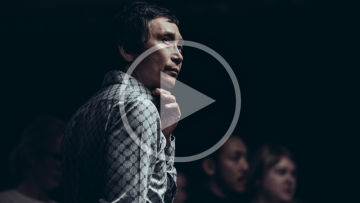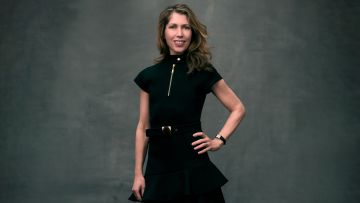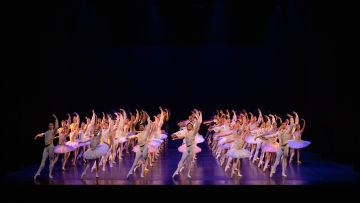Raising the bar for wellbeing
Written by Cassandra Houghton
Pas Magazine Issue 11

The year was 1995 when Tony Lewis – then a Principal Dancer at Queensland Ballet – found a few pieces of gym equipment in the local council kerbside collection and carried them to the Company’s studios at the Thomas Dixon Centre. Acid-wash jeans, scrunchies, crimped hair and punk rock were trending; wellbeing as we know it today, was not. But being an elite athlete, as all ballet dancers are, he knew the equipment would be appreciated, so he set up a gym area outside studios 1 and 2 on the upper level of the old building. A dancer who had recently left the company donated a few more pieces, and the company – then comprising 26 dancers – began to use the cheap weights bench, skinny spinlock barbell, and the collection of old steel and sand-filled plastic weights.
Queensland Ballet had been a successful not-for-profit arts company for just over 30 years under four talented artistic directors, but funds for a professional gym were unfeasible at a time where dancers were doing car washes and underground fashion shows to raise money for productions.
Fast forward almost 30 years to today, and thanks to generous support, Queensland Ballet has a home to finally match its ambitions around health and wellbeing. From the dancers’ gym, to the integration of natural light and access to nature, to the dedicated studio for all our community dance health programs, Queensland Ballet is striving for the best. And with wellbeing integrated into the design and operations of the building, it’s not just the dancers and staff, but also the public that benefits from the Thomas Dixon Centre’s WELL™ accreditation ambitions. Grounded in evidence-based research, WELL’s ten core concepts across light, air, mind, water, sound, nourishment, thermal comfort, materials, community, and movement aim to provide a healthy environment, which plays a key role in supporting human wellbeing and influencing the occupants’ and visitors’ healthy lifestyle choices.
“Each day when I walk into the gym I can’t help but smile, especially when I think of the rusty, broken equipment we had in 1995,” says Tony, who retired from the stage in 2003 and is now the Company’s Strength and Conditioning Coach.
“Our gym has everything we need. We are now able to test the dancers using specialised testing equipment. The data we gather from these tests can give us information on all the elements required in assisting them to be the best they can be. All the dancers’ Pilates and Strength programs are monitored using an athlete management system so they can track their training. We have an educated and progressive Performance Health Team that works with the Artistic staff in preparing the dancers for specific roles and upcoming seasons. It’s incredible.”
The future of wellbeing
With the 2022 refurbishment, it became clear a new role was necessary. Zara Gomes, former Queensland Ballet Physiotherapist and Head of Performance Health, was the perfect fit to be Director of Health and Community. Covering health, wellbeing, and the community health programs for dancers, staff and visitors, Zara’s promotion was a natural progression.
“When I first arrived at Queensland Ballet almost 12 years ago, there was only a visiting physio and massage therapist who came in a few hours a week. The vision was to set up a health team, and then once Li took over as Artistic Director, the company and his vision expanded from there,” Zara recalls.
“I set up a health team, steadily over time. It was a one-woman show from the Physiotherapy perspective for quite a while, but that vision took us from being behind some other ballet companies to now being really well positioned and providing excellent care for our dancers.
“Now we have four part-time in-house physiotherapists across the Company and Academy, as well as a strength and conditioning coach, massage therapists and a Pilates instructor. And we have a visiting podiatrist, sports dietician, and a range of external health consultants who we refer to regularly including sports physicians, GPs, performance psychologists and orthopaedic specialists covering every area of the body. It’s an amazing support system.”
As well as overseeing the performance health team, Zara advises on the WELL certification which requires regular staff trainings, repeated quality testing, and ongoing data reporting, as well as recertification every three years.
“It’s not a box we can tick and forget about, it’s an ongoing commitment that needs to be upheld,” Zara says.
And will it make a difference?
“Absolutely. I think it already has,” she says. “The WELL concepts have been embedded into the design right from the beginning so the building is built this way not just to look attractive or to be architecturally innovative. All those concepts of natural light, water and air quality and the connection to nature have been planned the whole way through and I think they’re almost intangible, and yet it makes a different to the environment and how you feel working here and visiting.
“Then there’s all the aspects of WELL that aren’t the built environment; it’s in the programs we run –the educational commitments to our staff on health and wellbeing, and the support we offer, and our community programs like Dance for Parkinson’s, Ballet for Brain Injury, and the Ballet for Seniors, Yoga and Pilates classes. And all of this will be increasing steadily, tailored to people’s needs.”
Meditation classes and even a dog-friendly office policy have been trialled successfully, while targeted workshops for topics like nutrition will continue regularly.
“It’s a tricky thing to try and satisfy everyone because every individual is different, but I think the more input and ideas we get, the more successful it will be,” Zara says.
“We could have renovated the Thomas Dixon Centre without the WELL considerations and goals and it would have been a less expensive project. But a lot of those concepts, we had already been working towards and so the WELL requirements help us with detailed guidelines about how to make it happen. We genuinely want to improve health and wellbeing across QB and those who engage with us. If people feel well, happy and healthy, they’ll be more productive, fulfilled and creative.”
One year since the move to the Thomas Dixon Centre, Zara says it’s often the little things that have given her personal satisfaction.
“I was involved in the early planning stage with the architects, and for the first couple of months after we moved in I would look out through the glass windows of the Physio treatment space and into the gym with its beautiful natural light and exposed brickwork and just think, this is exactly how I envisioned it,” she recalls.
“To see the Company enjoy it, and to see that it works functionally and well – that’s very satisfying.”






